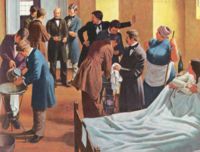Ignaz Semmelweis: Difference between revisions
imported>Caesar Schinas m (Bot: Update image code) |
mNo edit summary |
||
| Line 37: | Line 37: | ||
#Broemeling, L.D. "Studies in the history of probability and statistics: Semmelweis and childbed fever. A statistical analysis 147 years later." Dept of Biostatistics and Applied Mathematics, The University of Texas M.D. Anderson Cancer Center. | #Broemeling, L.D. "Studies in the history of probability and statistics: Semmelweis and childbed fever. A statistical analysis 147 years later." Dept of Biostatistics and Applied Mathematics, The University of Texas M.D. Anderson Cancer Center. | ||
#Semmelweis, I.P. "The cause, concept and prophylaxis of childbed fever." 1861. | #Semmelweis, I.P. "The cause, concept and prophylaxis of childbed fever." 1861. | ||
#Nuland, S. "The doctor's plague: germs, childhood fever, and the strange story of Ignac Semmelweis." Williams and Willkins Norton, 2003. | #Nuland, S. "The doctor's plague: germs, childhood fever, and the strange story of Ignac Semmelweis." Williams and Willkins Norton, 2003.[[Category:Suggestion Bot Tag]] | ||
Latest revision as of 06:01, 31 August 2024
Ignaz Semmelweis (1818-1865) was a 19th century Austro-Hungarian physician. He is best remembered for his contributions in combating "childbed fever", using modern scientific methods and statistics.
Background
Until the 17th century, most births took place at home. As so-called "lying-in" hospitals became popular, more and more women came to the hospital for childbirth. These births were usually attended by midwives or doctors. With the advent of these hospitals came the increase in the phenomenon of "childbed fever", or "puerperal sepsis". This phenomenon had been described centuries before, but it was not until the 18th and 19th centuries that the disease became more widely recognized. At the time of Semmelweis's career, the germ theory of disease had not yet been formulated. Several other ideas held sway, such as that of miasmas (basically "ill winds") and "humoral imbalance". Semmelweis received the classical medical training of the time, including indoctrination into these theories, which had not substantially changed in two thousand years.
Puerperal Fever
Puerperal fever is a devastating disease. Today we would simply call it "sepsis". It is caused when bacteria and bacterial toxins cause an overwhelming infection and immune reaction, often killing the patient. Even with modern antibiotics, sepsis carries a high mortality rate. During childbirth, the mother's blood stream is uniquely exposed to the environment, allowing for the ingress of bacteria. The disease would often kill up to 15-20% of mothers at lying-in hospitals.
Semmelweis's Breakthrough
Dr. Semmelweis was not the only physician to take a special interest in the problem. In the U.S. Oliver Wendell Holmes had noted similar trends, but at the time, the U.S. was far behind Europe in medical science, and communication between American and European scientists was poor. The unique contribution of Semmelweis was that he not only observed the phenomenon of childbed fever, but he kept detailed tables of how many women were affected, where they gave birth, and who attended the birth. This was in the era that gave birth to modern statistics. At the time, most statistical techniques were primitive by modern standards, but did involve very careful data collection, allowing for modern reinterpretation of the data. What Semmelweis observed was that a much higher number of women were dying when attended on the physician and medical student ward, versus those attended by midwives.
Formulation and Testing of Hypotheses
Semmelwies developed several hypotheses to test, among them:
- Overcrowding on certain wards spread the disease. He tested the hypothesis by comparing sepsis deaths on floors based on crowding. The statistics did not support the hypothesis, so it was abandoned.
- Doctors and medical students some how passed "particles" of disease to patients. A close friend of Semmelweis had died of a disease indistinguishable from childbed fever after cutting his hand during an autopsy. Semmelweis noted that often, doctors and medical students would perform autopsies, then go to the ward to deliver babies, one after the other. Midwives did not. He posited that particles of illness were making mothers ill, and that washing hands might prevent illness. He tested this by instituting a strict regimen of hand washing with a chlorine-lime solution before examining mothers or delivering babies. The death rate from sepsis quickly fell to the level seen in the midwife deliveries. The hypothesis was successfully tested elsewhere, as mentioned above, but communication was poor. The hypothesis had been tested and made correct predictions.
It was immediately and resoundingly rejected.
Paradigm Shift and Acceptance
Semmelwies died at 47 of an unknown illness in an asylum for the insane. He did not live to see the success of his methods. Just a few years after his untimely demise, other researchers, such as Billroth (discovery of streptococci in pus), Pasteur (discovery of strep in the blood of a septic woman), and Lister (pioneer of antisepsis in surgery) helped overturn the old order. The humoral and miasma theories of disease were gone, to be replaced by the germ theory.
Significance of Statistics
Ignaz Semmelweis was one of the first scientists to use formal data collection and statistics to test a hypothesis. Statistics was in its infancy as a science, but modern statisticians have evaluated his data and confirmed his conclusions. The use of the scientific method and statistics is the basis of modern medicine.
References
- De Costa, C. "The contagiousness of childbed fever: a short history of puerperal sepsis and its treatment." MedJourAustralia, Vol 177, 2/16 December 2002.
- Best M, Neuhauser, D."Ignaz Semmelweis and the birth of infection control." Qual Saf Health Care (BMJ), 2004;13:233-234.
- Broemeling, L.D. "Studies in the history of probability and statistics: Semmelweis and childbed fever. A statistical analysis 147 years later." Dept of Biostatistics and Applied Mathematics, The University of Texas M.D. Anderson Cancer Center.
- Semmelweis, I.P. "The cause, concept and prophylaxis of childbed fever." 1861.
- Nuland, S. "The doctor's plague: germs, childhood fever, and the strange story of Ignac Semmelweis." Williams and Willkins Norton, 2003.

